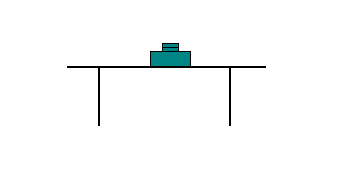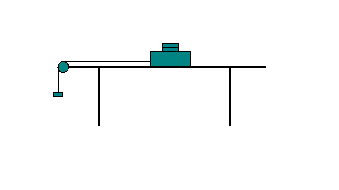
Name:_______________________________Date:__________Time:_________
Course:_________________
________________________________________________________________________
Kinetic Friction
Activity I
Purpose: To study the laws of friction and to determine the coefficient of kinetic friction (µk) between two surfaces, wood block and the lab-table top.
Apparatus: pulley and supporting rod, wood block, mass set, mass hanger, string, and balance.
Theory:

In the above diagram, a wood block of total mass, m (m = mb + mt, where mb is the mass of the block and mt is the mass on top) is placed on the laboratory table. Show the forces acting on the wood block, in the diagram above and also in the diagram below.

Now, a string is attached to the wood block and it is passed over a pulley and a hanging mass, M is hanged as shown above. Show the pulling force and the frictional force in the diagram above.
Answer the following questions:
1. What is the pulling force?______________________
2. What will happen if the frictional force is greater than the pulling force.
_________________________________________________________________
3. What will happen if the frictional force is less than the pulling force.
_________________________________________________________________
4. When do you think the frictional force will be equal to or almost equal to the pulling force.
_________________________________________________________________
If Mg is the weight to make the block to move at constant velocity or with almost zero acceleration,
Ffr = Mg and
FN = mg, where m = mb + mt.
According to the law of kinetic friction,
Ffr = µk FN.
Hence Mg = µk mg
M = µk m
Hence plotting M Vs m will give a slope of µk.
Procedure:
1) Find the mass of the wooden block and record the value in data table I.
2) Make sure that the surfaces of both the wood block and the lab-table are clean. Wipe them off with a paper wipe if necessary. Do not touch the surfaces with your hands.
3) Place the block on the lab-table and place a 50 gram mass on top of the wooden block.
4) Run the string attached to the block over the pulley and attach it to the mass hanger. Make sure the string is parallel to the lab-table's surface.
Q: Why is it necessary that the string is parallel to the surface of the lab-table?
________________________________________________________________
5) Determine the least amount of mass, M, necessary to slide the block with a constant speed after it has been started with a very small push. Record the value of M in data table I.
Q: Why is it necessary to find the least amount of mass, M that will make the block to move?
________________________________________________________________
6) Repeat procedure 5 for other masses on top of the block and complete table I.
7) Plot a graph and determine the value of µk. Attach a hard-copy of it.
DATA TABLE I
mass of the wooden block, mb = ---------
|
mt |
M |
m = mb + mt |
|
50 |
- |
- |
|
100 |
- |
- |
|
150 |
- |
- |
|
200 |
- |
- |
|
250 |
- |
- |
|
300 |
- |
- |
|
350 |
- |
- |
|
400 |
- |
- |
µk from the graph = ______________________
Write a conclusion for the above activity:
Activity II
Purpose: Determine the coefficient of kinetic friction (µk) between two surfaces, wood block and the lab-table top, by measuring the acceleration using the photogate/pulley system.
Apparatus: PC, photogate/pulley system, wood block, mass set, mass hanger, string, and balance.
Theory:

Now we will hang the mass so that the pulling force is greater than the frictional force, and hence the block will accelerate.
Show all the forces acting on the block, and the acceleration in the diagram above and derive an expression for µk in terms of M- hanging mass, m- total block mass, a- acceleration of the block-mass system, and g- acceleration due to gravity.
Procedure:
1)
Connect
the Photogate/Pulley system to digital channel one on the Interface and turn on
the interface.
2)
Open
DataStudio. Click on “Open
Activity”. Click "Library". Click "Physics Labs folder".
Select “P21 Kinetic Friction” in the Physics Labs folder.
3)
Use the
pulley mounting rod to attach the pulley to the tab in the center of the
photogate.
4)
Clamp
the mounting rod to a table clamp so that the pulley is pointed towards the
ceiling.
5)
Measure
the mass of the friction block and record it in the Data Table.
6)
Cut a
piece of string that is approximately 10 cm longer than the distance from the
table to the floor. Attach one end
of the string to the block. Make
sure that the largest possible surface of the block is making contact with the
table.
7)
Run the
string through the groove in the pulley and attach a mass hanger to the other
end of the string.
8)
Attach
enough masses to the hanger so that the block will slide on the table without a
push. Record the total value of the
masses (including the mass hanger) in the Data Table.
9)
Pull the
block until the hanging mass is almost up to the pulley. Hold the block in place. Turn the pulley until the LED is no
longer lit up.
10)
Click on
the Start button.
11)
Release
the block. Click on the Stop button
before the block hits the pulley.
DO NOT LET THE BLOCK HIT THE PULLEY.
12)
Repeat
steps 9-11 with a mass placed on top of the block roughly equivalent to the mass
of the block and double the hanging mass.
Record the new masses in the Data Table.
13)
Repeat
steps 9-11 with the original hanging mass and without the mass on the block but
with the block turned so that the smaller side of the block is in contact with
the table.
14)
Determine the experimental
acceleration for each of the data runs.
(The slope of the velocity vs. time plot). Record the values in the Data
Table. The easiest way to determine
the slope is to click on the data run and select Linear Fit from the Fit
menu.
16) Using the mass values and acceleration value, determine and record the coefficient of kinetic friction for each data run in the Data Table.
DATA TABLE II
| Total block mass, m | Total hanging mass, M | Exp. acceleration, a | Coeff. of kinetic friction, µk |
Use your data and answer the following questions:
1) How does the coefficient of kinetic friction vary with the total mass of the block?
2)
How does
the coefficient of kinetic friction vary with the area of contact between the
block and the table?
3) How does the coefficient of kinetic friction vary as the speed/acceleration varied due to the different hanging masses?
4)
When the
total mass of the block is increased, does the force of kinetic friction
increase? Why?